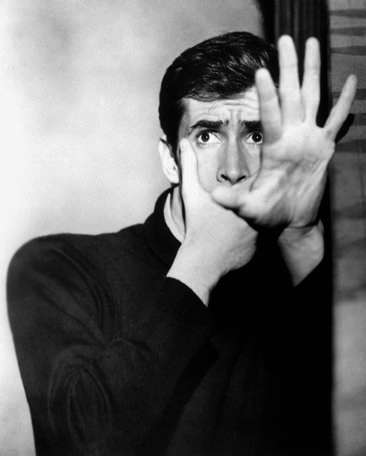A note on Psycho
 I thought I'd watch Psycho this afternoon, seeing as I hadn't seen it in a couple of years and my recent poking about the 'Nets regarding Vertigo made me want to see it again. As I watched, I was reminded of something I'd read years ago about Flannery O'Connor's famous story, "A Good Man Is Hard to Find."
I thought I'd watch Psycho this afternoon, seeing as I hadn't seen it in a couple of years and my recent poking about the 'Nets regarding Vertigo made me want to see it again. As I watched, I was reminded of something I'd read years ago about Flannery O'Connor's famous story, "A Good Man Is Hard to Find."
That article was critical of the story because, in the writer's opinion, it was flawed structurally: the story's main character is--or appears to be--the grandmother . . . until the arrival of the Misfit in the final few pages, when he wrests control of the story's point of view from the grandmother. To my mind, though, that's precisely O'Connor's goal: the grandmother, complacent, to put it kindly, regarding her beliefs about good and evil, can never learn what she is to learn unless her vision of the world is not merely questioned but utterly shaken, causing her to examine her faith. But even if we put aside O'Connor's thematic concerns and consider that story's sheer power, that wresting of control works on the reader--or the writer of this post, at least, never failing to send chills down my spine, as often as I have read it. It is as though the Misfit assaults usas well--that is, our point of view as it's been shaped by that of the grandmother. We may disapprove of the grandmother's blind complacency, but--just as the Misfit notes at the end of the story--we sense she is at heart "a good woman." If it doesn't shake us as well, then we are no different from the grandmother, prior to her extraordinary gesture toward the Misfit at the very end of her life.
Psycho, it struck me today, has a similar narrative structure, though its purpose is more psychological than thematic. This film is so familiar that it is hard to describe how it works on the viewer as though s/he is experiencing it for the first time, but I'll give it a go.
For its first half-hour, Marion Crane is the center of what starts out as a very noir-ish narrative. But there is still the film's title to account for. Who will this "psycho" turn out to be? We have several candidates: Marion herself; Sam Loomis (her boyfriend); the highway patrol officer; perhaps even the man whose money Marion steals. Aside from Norman's twitchiness and his odd fixation on his mother as he talks with Marion, we have no reason to suspect him of anything worse than being a bit of a momma's boy.
Marion arrives at the Bates Motel 26 minutes into the film; 18 minutes later, Marion is dead and we have our answer. Norman Bates now becomes the film's center. If I had to guess, what shakes us as viewers, once our shock from the violence of Marion's death wears off, is the fact that at the moment we have no explanation for her death yet have no choice but to accept the fact that someone who has something to do with her death is now the filter through which the film's subsequent action will pass . . . we guess. Norman=Misfit. Marion is much more in this film than Norman Bates' victim; she had been our lodestone for this narrative. And now she's gone.
In the making-of feature that comes on the DVD, Janet Leigh mentions two things that are interesting within the context of this particular film's narrative structure. The first thing is that she says she's often been asked if she felt slighted for being billed as the lead actress for Psycho and yet is onscreen for such a short time. Though she doesn't quite say this, her response is that she understands herself as an actress not to be the point of the story but in service to it. The other intriguing thing is that she says the only instruction Hitchcock gave her was that his camera was the focal point in the film, that when the camera moved, she had to, and she was not to move independent of its moving. Rather than feel that as limiting her, Leigh says she instead looked for her motivations for moving not in herself but in the camera's movements. In other words, she worked in service to the story.
Psycho, like all of Hitchcock's best films, pays close attention to character development, but I think in this one narrative--specifically, forcing the audience to examine its expectations and assumptions about narrative--is Hitchcock's larger goal.
Technorati tags:
Film, Movie, Alfred Hitchcock, Psycho, Narrative, Structure, Flannery O'Connor, "A Good Man Is Hard to Find",































2 comments:
It's been a while since I watched the movie, but (assuming we've never seen it before) do we really know it's Norman? We see the dress & hair, so aren't we led to believe that Mrs. Bates is the killer? Correct me if I'm wrong.
Philip,
A belated thanks for coming by and commenting.
The film's climax shows someone, revealed to be Norman in drag, about to attack Vera Miles' character when he's restrained. Then at the film's end comes the psychologist's explanation of Norman's psychosis.
Post a Comment